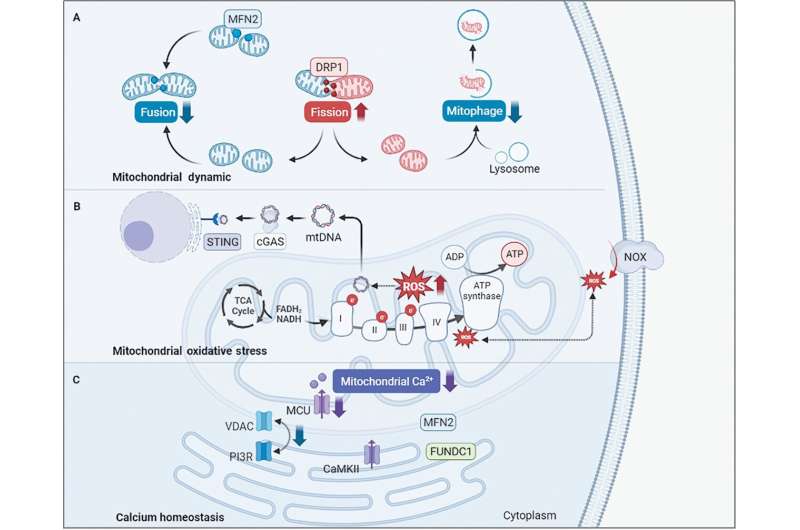
Diabetes is a global health burden. A whopping 536 million people worldwide struggle with diabetes. Diabetic cardiomyopathy (DC) is a serious condition characterized by impaired heart function due to diabetes-related metabolic abnormalities.
It is a complex, multi-faceted condition where the heart fails to efficiently pump blood into the body. Insulin resistance, abnormal mitochondrial dynamics, oxidative stress, and impaired calcium handling are some of the underlying mechanisms that contribute to DC.
Traditional treatment strategies have often focused on controlling blood glucose levels and managing cardiovascular risk factors. However, recent advancements in understanding the intricate mechanisms underlying DC have paved the way for targeted therapeutic interventions.
Dr. Tao Li from West China Hospital, Sichuan University, China, and his team conducted a review to understand various aspects of metabolic dysregulation in diabetic cardiomyopathy. Their study was published online on March 25, 2024 in the Chinese Medical Journal.
“We reviewed the current knowledge of the reprogrammed mitochondrial energy metabolism in diabetic cardiomyopathy by elaborating how the changed catabolism of glucose, FAs, lactate, ketone bodies, and branched-chain amino acids (BCAAs) participates or counteracts the pathogenesis, and highlighting the emerging mitochondrial metabolism targeted therapies,” explains Dr. Li.
Maintaining mitochondrial integrity and activity is crucial for energy production. However, in diabetes, the processes of mitochondrial formation (fusion) and mitochondrial fragmentation (fission) are both dysregulated.
“In DC, mitochondrial fusion decreases, as indicated by a significant decrease in mitofusion 2 (MFN2) expression. The overexpression of MFN2 in diabetic hearts has been shown to reduce reactive oxygen species (ROS) production and normalize fission. And MFN2 expression can be regulated via the peroxisome proliferator-activated receptor (PPARa),” explains Dr. Li. Mitophagy is an important step involved in the elimination of damaged mitochondria.
Imbalance in mitochondrial dynamics and dysregulation of mitophagy are precursors to the development of DC.

In diabetic hearts, inefficient energy compensation leads to excessive electron and ROS production, which play a significant role in DC. Mitochondrial calcium regulates pumping of the heart, and its dysregulation affects multiple functions. Increased levels of mitochondrial calcium can damage cardiomyocytes, whereas decreased levels can decrease glucose utilization, increase fatty acid utilization, and impair adenosine triphosphate (ATP) production.
The heart consumes approximately 8% of the body’s total energy, derived from ATP. The diabetic heart struggles to meet the ATP demands of myocardial activities, leading to the initiation of abnormal metabolic pathways and a shift in substrate preferences. Fatty acids and lactic acid, chosen to compensate for the ATP deficit, prove to be less efficient substrates, resulting in oxidative stress and subsequent myocardial damage.
Additionally, BCAAs, such as leucine, isoleucine, and valine, contribute to inefficient ATP production, and their accumulation is associated with reduced glucose metabolism, rendering the heart vulnerable to ischemic injury. Altered metabolites with damaged mitochondria further promote myocardial injury and contribute to cardiac dysfunction.
In contrast, ketone bodies are proposed as an alternative metabolic fuel in diabetic cardiomyopathy as they serve as efficient substrates. “Recently, in streptozotocin-induced diabetic rats, a ketogenic diet was demonstrated to enhance cardiac function by increasing ketone utilization, suppressing fatty acid metabolism, and reducing inflammation. Ketone bodies may play a regulatory role in modulating other energy substrates,” says Dr. Li.
Considering the complex interplay of mitochondria, insulin, glucose, calcium, and metabolic pathways, there is no specific treatment for DC. The gold standard strategies focus on maintaining optimum blood glucose levels, managing the progression of associated comorbidities, and treating heart failure. GLP-1 RA and sodium-glucose transporter are clinically proven anti-hyperglycemic agents that are clinically well-established.
Statins, such as atorvastatin and fluvastatin, have cardioprotective effects as they reduce low-density lipoprotein cholesterol levels. Ketogenic therapies involve the consumption of low-glycemic foods where the energy source shifts from glucose to ketones, thereby reducing the burden on insulin.
The study offers insights into the key role of mitochondrial energy dysregulation and mitochondrial oxidative stress in DC. Mitochondria-oriented therapies, including antioxidants such as MitoTEMPO, have emerged that offer cardioprotection.
The study represents a significant milestone in understanding the complexities of DC and underscores the urgency of advancing novel therapies to combat this debilitating condition. Further research to explore the detailed pathogenesis of mitochondrial energy metabolism in DC could pave the way for precise mitochondria-oriented therapies to effectively treat this disease.
More information:
Wanlin Ye et al, Mitochondrial energy metabolism in diabetic cardiomyopathy: Physiological adaption, pathogenesis, and therapeutic targets, Chinese Medical Journal (2024). DOI: 10.1097/CM9.0000000000003075
Provided by
Cactus Communications
Citation:
Review identifies disrupted mitochondrial metabolism as a trigger for diabetic cardiomyopathy (2024, April 4)
retrieved 4 April 2024
from https://medicalxpress.com/news/2024-04-disrupted-mitochondrial-metabolism-trigger-diabetic.html
This document is subject to copyright. Apart from any fair dealing for the purpose of private study or research, no
part may be reproduced without the written permission. The content is provided for information purposes only.
Source link




